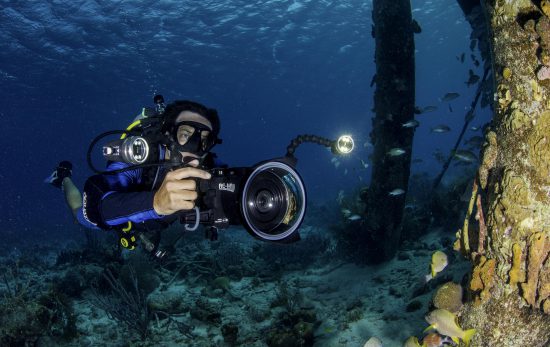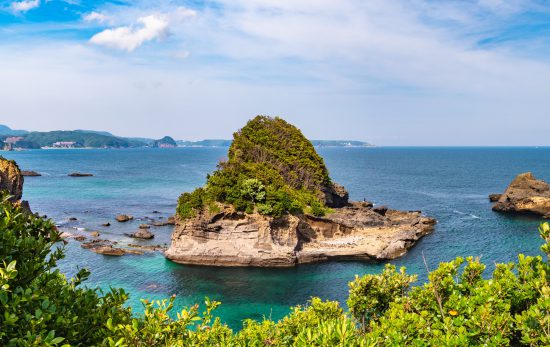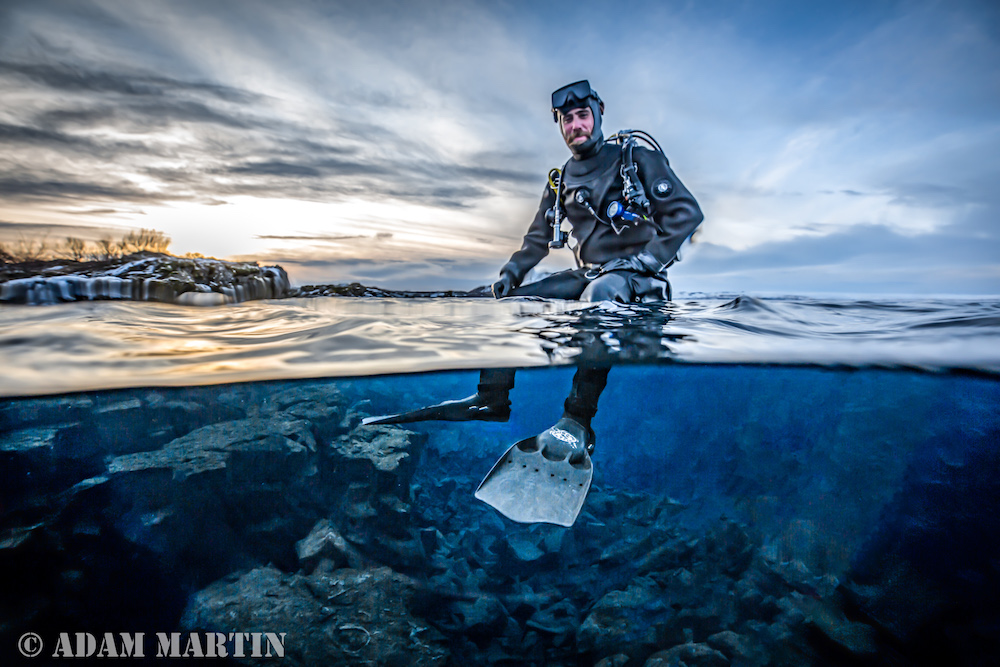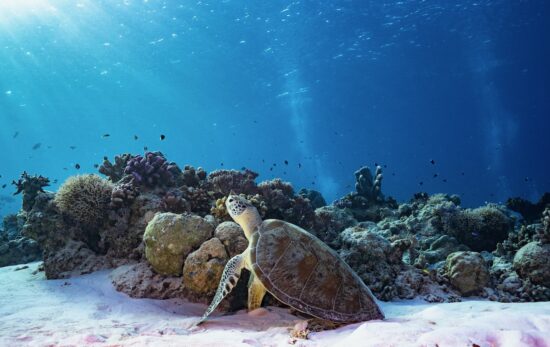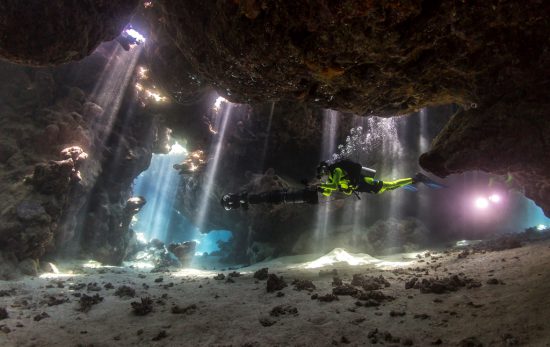While many divers are satisfied within the limits of recreational scuba diving, some may feel the call to explore deeper into the underwater world. Technical diving allows scuba divers to do just that. While the definition of tec diving is constantly shifting due to the overlap of commercial and military diving with recreational diving, we offer the following definition for this article. We will define tec diving as any dive where a direct and safe ascent is not possible. This includes dives below 130 feet (40 meters), multiple mix gas diving, ice or cave diving where an overhead environment exists beyond 130 linear feet (40 meters) of the surface, and wreck diving with penetration.
If you’re a no-holds-barred tec diver, consider these ten dive sites for your next scuba diving adventure.
1. SMS Markgraf – Scapa Flow, Scotland
At the conclusion of World War I, 52 German vessels were scuttled off the Orkney Islands in Scotland to prevent the ships from falling into the hands of the British. After significant salvaging efforts between 1920 and 1945, only 7 ships remain. These massive battleships join British naval vessels and block ships to create a tec diving wonderland. The SMS Markgraf, in particular, is in pristine condition, demonstrating the impressive size of the German battleships. In 150 feet (45 meters) of water, the Markgraf requires a degree of technical diving to reach its iconic features.
- Dive Type: Wreck
- When to Go: April to October
2. The Gunilda – Rossport, Canada
The Great Lakes are home to untold numbers of shipwrecks. The depth of the lakes mean that many will never be discovered. However, those that are remain in perfect condition due to the cold, freshwater conditions. The Gunilda was reputed to be one of the most beautiful private ships of her day. Built in 1897, Lake Superior claimed the ship in 1911 while she was under ownership of affluent New Yorker William L. Harkness. The luxurious boat ran aground against a shoal. All of the passengers made it to safety, but left their possessions behind as they were sure the boat wasn’t really going to sink. But during attempts to save her, she fell off the shoal to a depth of 262 feet (80 meters). Few divers have ever been brave enough to dive the Gunilda, but those that do are astounded by the pristine ship that remains on the lake floor.
- Dive Type: Wreck
- When to Go: June to September
3. Andrea Doria
Often called the “Everest of Wreck Diving,” the Andrea Doria is known for its challenging conditions. An overly ornate, Italian luxury liner of the post World War II era, the Andrea Doria met her demise after colliding with another passenger liner. 1,660 of her passengers and crew were rescued, but the ship came to her rest in 1956 on her starboard side in 250 feet (72 meters) of water. The problem with diving the Doria is that conditions are highly variable. At times, the visibility can reach 100 feet (30 meters), but more than often, it sticks at 10 feet (3 meters). Currents can change at the blink of an eye, and while penetration is possible, the ship’s rapid deterioration makes this a risk. However, the willingness of divers to explore this wreck since the 1950s has pushed technological advances in tec diving equipment and furthered the sport without measure.
- Dive Type: Wreck
- When to Go: June to September
4. Biofilter Bay – White Sea, Russia
Ice diving attracts a certain type of diver – one who is ready for adventure, cold and ever-changing conditions. As the only sea in Europe that completely freezes, the White Sea regularly attracts these types of divers. One site in particular, Biofilter Bay, is known for its dramatic ice formations caused by the huge change between high and low water levels as well as the area’s currents. Do note that ice diving is only considered tec diving further than 130 linear feet (40 meters) from the opening in the ice.
- Dive Type: Ice Dive
- When to Go: January to April
5. The Pit – Tulum, Mexico
The deepest cenote in Quintana Roo, The Pit is ideal for tec divers who like the challenge of deep diving in a confined environment. Light penetrates the cenote down to 100 feet (30 meters) where a layer of hydrogen sulfate awaits. Below this cloud, an ancient yet unintended burial ground can be explored by divers with proper training. Animal and human remains were once found here.
- Dive Type: Deep and Cave Dive
- When to Go: May to September
6. Devil’s Den – Williston, Florida
Sometimes called Devil’s Den Cave or Devil’s Den Springs, this dive site has long attracted cave divers to its depths. The cave itself sits on private property, but divers are welcome during business hours. Inside, you’ll find a spring with an “inverted mushroom” shape which reaches 200 feet (61 meters) across. From the larger room of the cave, four underwater passages extend between 5 and 90 feet (1.5 and 27 meters) below the surface. Tec divers can explore these passages with proper training.
- Dive Type: Cave Dive
- When to Go: Year-round
7. Blue Hole – Dahab, Egypt
A beacon for tec divers around the world, the Blue Hole in the Red Sea drops to over 400 feet (100 meters). Inside you’ll find excellent visibility, plenty of marine life and coral-lined walls. The Arch, which connects the blue hole with the open water at 170 feet (52 meters) is often a goal of tec divers. But, remember that this can be a risky endeavor and only fully trained divers should try to dive so deep.
- Dive Type: Blue Hole
- When to Go: March to November
8. San Francisco Maru – Chuuk Lagoon, Micronesia
Chuuk (Truk) Lagoon in Micronesia is known as the home of the “Ghost Fleet.” At the end of WWII, a concentration of Japanese ships made the natural harbor a target for Allied forces who bombed the area in 1944. 12 warships, 32 merchant ships and 275 aircraft were ultimately sunk. Today, the San Francisco Maru is one of the remaining wrecks. Sitting in 210 feet (64 meters) of water, the 385-foot (117-meter) passenger ship has holds that are filled with mines, torpedoes and even three tanks. The deck is located at 160 feet (49 meters), so tec diving is a requirement to explore this amazing wreck.
- Dive Type: Wreck Dive
- When to Go: December to April
9. HMS Hermes – Batticaloa, Sri Lanka
One of the very few aircraft carriers that can be dived, the HMS Hermes is found off the east coast of Sri Lanka. She was sunk in early 1942 by the Japanese, and despite obvious deterioration, several key areas of the wreck are still clearly visible including the control tower. Sitting on her port side between 137 and 173 feet (42 and 53 meters), this massive ship has only been explored since 2009 due to recent political instability in Sri Lanka.
- Dive Type: Wreck Dive
- When to Go: May to October
10. The Drop Off of Verde Island – Puerto Galera, Philippines
Puerto Galera is a scuba diving heaven for recreational and tec divers alike. Here the reefs and drop offs extend from shallow depths all the way down to around 250 feet (75 meters). In particular, the walls of Verde Island are worth exploring. At the Drop Off, you can expect to dive straight down a wall to the sloping sea floor. Looking up, you’ll see an underwater mountain towering above you. Current can be strong, but the site’s proximity to deep water means you’ll never be bored for big fish life.
- Dive Type: Wall Dive
- When to Go: November to June
Gear Up! Technical Diving Equipment
Diving beyond recreational limits certainly requires a different set of scuba gear. Tec divers typically use twin cylinders or rebreathers (CCRs). They may also carry additional tanks with a variety of gas blends. Plus, it’s vital to backup scuba equipment at such depths. These divers usually include two dive computers and independent regulators in their kit. Finally, an adequate exposure suit is absolutely necessary. Tec divers may own a dry suit as well as wetsuits in a variety of thicknesses.
Are you a technical diver? Locate a PADI TecRec Center and start crossing off some of these incredible dive sites!
